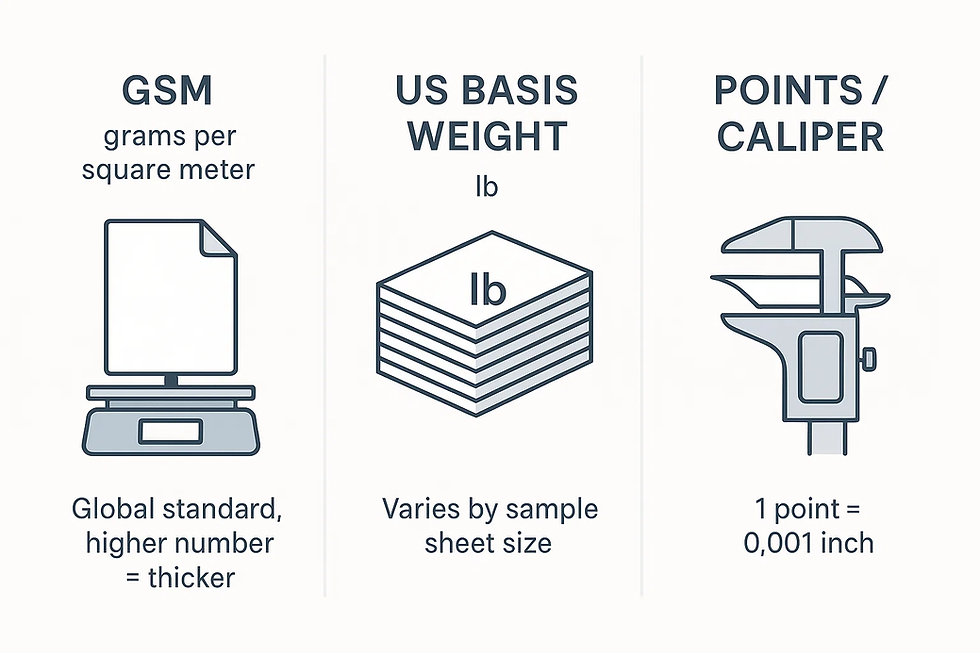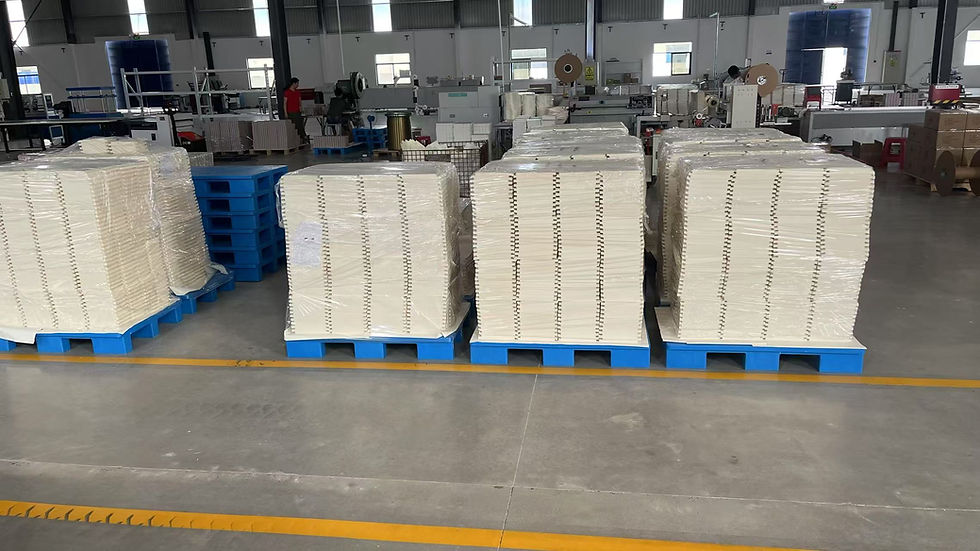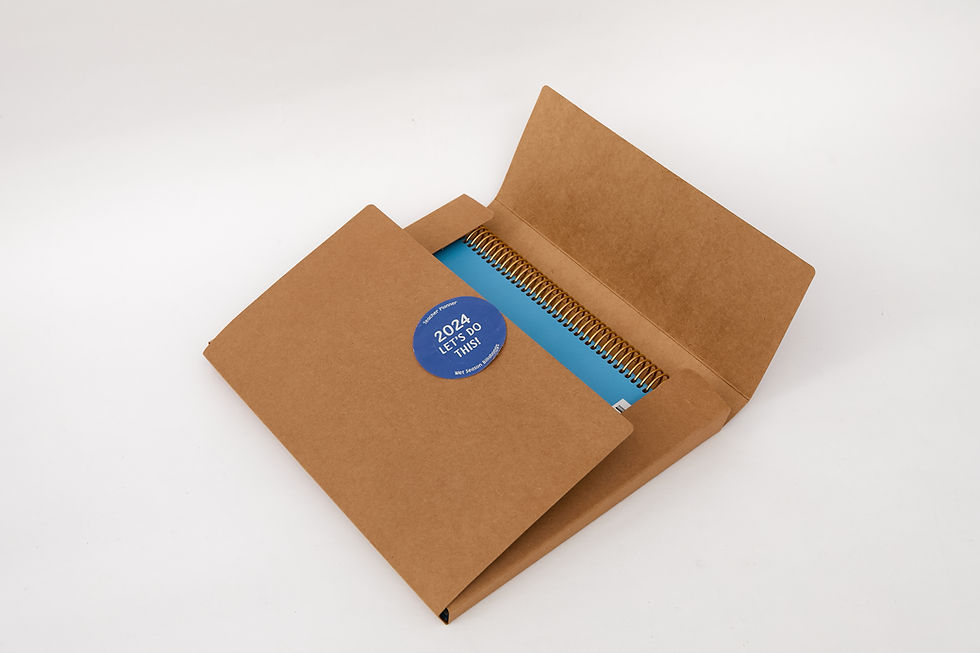The Best Guide to Paper Weight 2026
- Leo Xia

- Aug 25
- 11 min read
Quick Content Reach:
Introduction – Why Paper Weight Matters for Stationery Professionals
When a buyer picks up a notebook, planner or journal, the first sensory cue is the way the paper feels. A silky smooth page with the right heft silently communicates quality, while a flimsy sheet can cheapen even the most beautiful design. Paper weight is more than a technical specification – it is the tactile expression of your brand. Studies within the printing community show that the right paper weight can transform a brochure or booklet into a premium experience. Whether you are sourcing products for a stationery store, managing a new line of planners on Amazon or designing bespoke corporate journals, understanding paper weight helps you select materials that delight users and reinforce your brand values. Throughout this guide you will find practical advice and data-backed recommendations, drawn from industry‑leading references, to help you choose the right paper weight for your products.

If you have questions at any point, contact our professional team at Lion Paper Products – we are always here to help you build a better writing experience.
Understanding Paper Weight: Key Measurement Systems
U.S. Basis Weight (Pounds)
In the United States, paper weight is traditionally measured in pounds.
The basis weight refers to the weight of 500 sheets (a ream) of paper cut to its uncut “basic” size. For example, a ream of 20 lb bond paper weighs twenty pounds before it is cut down to letter size. Because different categories of paper have different uncut sizes (bond paper is 17 × 22 inches, cover stock is 20 × 26 inches, etc.), the same pound rating can result in different thicknesses. That is why 80 lb text paper is thinner than 80 lb cover stock. When evaluating basis weight:
Heavier numbers generally mean thicker paper, but comparisons across types are tricky due to different uncut sizes.
Bond (copy) paper is typically available in 16–36 lb weights for everyday printing, letterhead and stationery.
Text (book) paper spans 50–100 lb and is used for brochures, magazines and internal pages of books.
Cover (cardstock) ranges from 60–120 lb and provides stiffness for business cards, invitations and durable notebook covers.
If you are designing notebooks or planners and want to convey luxury without making pages too stiff, consider text paper in the 70–80 lb range. To discuss which pound rating suits your products, reach out to our sales consultants for personalised guidance.
Metric Weight (GSM – grams per square metre)
For global projects and cross‑type comparisons, GSM is the preferred measurement.
GSM measures the weight of a single sheet of paper exactly one square metre in size. Because the area is fixed, GSM offers a direct comparison across paper types. For instance, 80 lb text paper is roughly 120 gsm, while 80 lb cover paper is about 216 gsm. Higher GSM indicates heavier and usually thicker paper.
The process of measuring GSM is straightforward: a 100 cm² sample is weighed in grams and multiplied by 100. This consistency is why most international suppliers and brands specify paper weight in GSM.
Points or Mils (Paper Caliper)
Paper thickness (caliper) is expressed in points, where 1 pt equals 1/1000 inch.
Thickness is measured using a micrometer and indicates how rigid a sheet feels. Two papers with identical weight can have different thicknesses due to fiber composition, coatings or the calendering process. Heavy coatings compress fibers, making paper thinner without changing its weight.
Understanding caliper helps you avoid paper jams in printers and ensures that folded products like planners or calendars do not crack.
If you are unsure whether your selected paper will work with your printing equipment or binding method, consult our production team; we will test and recommend the optimal combination.

Paper Weight Categories and Their Applications
Lightweight Papers (75–90 gsm / 20–24 lb)
Lightweight paper is the workhorse of notebooks and journals. It is ideal for multi‑page products because higher pages per inch make books manageable and portable.
Lightweight bond paper (75 gsm) is perfect for everyday printing and internal memos, while 24 lb (90 gsm) paper gives correspondence a slight upgrade. Pros include versatility and suitability for large notebooks; cons include lower tensile strength and possible show‑through. When planning journals or diaries for bulk sale, consider 80–90 gsm paper for a balance of weight and opacity, but always test for your pens and inks.
To source lightweight papers that perform well with various inks, contact our procurement experts.
Medium Weight Papers (170–216 gsm / 65–80 lb cover)
Medium weight papers include cover stock and card stock used for notebook covers, calendars and premium interior pages.
Typically ranging from 65 to 80 lb (170–216 gsm), this category is sturdy enough for embossing and die‑cutting, yet printable on many home and office printers. PrintingCenter USA notes that 80 lb (216 gsm) cardstock works well for booklet covers and corporate brochures.
If your notebooks require durable covers with foil stamping or lamination, medium weight paper is an excellent choice. Reach out to us to explore samples and discuss custom finishing options like matte or gloss lamination.
Heavy and Extra‑Heavy Papers (220–400 gsm / 80–200 lb)
For high‑end notebooks, planners or special editions, heavier stocks convey luxury.
Heavy cardstocks (110–130 lb) are often used for invitation cards, high‑end business cards and standalone covers. Extra‑heavy papers above 200 lb provide exceptional rigidity and are comparable to chipboard. While these papers offer durability and are perfect for embossing or metallic stamping, they can be expensive and may require special printing equipment. Use heavy paper sparingly for gift boxes, slipcases or collectible journals.
To determine whether heavy paper suits your project and budget, request a free consultation with our R&D team.
Specialty Papers and Other Types
Beyond standard bond and cover stocks, there are numerous specialty papers.
Book paper (30–115 lb) is used for printed books, catalogs and magazines.
Index paper (90–140 lb) serves for index cards and dividers.
Tag paper (50–100 lb) is durable and used for retail tags and table tents.
Text paper (50–100 lb) is common for brochures and letterhead.
Understanding these categories helps you select the right stock for calendars, planners, pouches and even gift packaging. For custom orders requiring unusual textures or eco‑friendly materials, let us know; our global supply chain can source or develop the perfect specialty paper.

How to Choose the Right Paper Weight for Specific Products
Notebooks and Journals
For everyday writing journals, choose paper weights between 80–100 gsm.
This range provides enough opacity to prevent ink bleed while keeping notebooks slim and easy to carry. Premium journals designed for fountain pen users may use 100–120 gsm for a smoother feel and to minimize feathering.
Consider your audience: corporate executives often appreciate thicker pages for a premium feel, while students value portability. To discuss the right combination of paper and binding for your notebooks, contact our specialists—we can customise the GSM, ruling and finish to your specifications.
Planners and Calendars
Planners and calendars often need thicker paper because users write on them daily and may use markers or highlighters.
Paper weights of 90–120 gsm are popular for planner pages, while covers can be 200 gsm or higher. Calendar pages require stiffness to hang flat; 100–150 gsm paper with a matte coating allows for crisp printing without show‑through. When designing corporate planners or wall calendars, think about the binding method (wire‑O, spiral or perfect binding) and match the paper weight accordingly. Let us help you select paper and binding that complement your design and meet your budget.
Notepads and Memo Pads
Notepads and memo pads are disposable yet must feel substantial enough for professional settings.
A 20–24 lb bond paper is standard. For premium notepads used in boardrooms, 28–32 lb bond paper (105–120 gsm) adds gravitas. Incorporate tear‑off sheets with micro‑perforations and glue padding for easy removal. Our production team can advise on the best paper weight and padding technique—get in touch to discuss options.
Sketchbooks and Artist Journals
Artists require thicker paper to prevent bleed and allow layering. Opt for 140 gsm and above; watercolor pads may use 200–300 gsm. Some extra‑heavy papers (300+ gsm) allow wet media without warping. Because heavy art paper is expensive, consider offering sketchbooks with fewer pages but higher GSM to maintain a competitive price point. Ask our team about paper options specifically designed for markers, watercolor or mixed media.
Gift Bags, Packaging and Stationery Accessories
Gift bags and packaging demand sturdiness. Use cardstock weights above 200 gsm for bags and boxes; for small accessories like tags or stickers, 80–100 gsm suffices. Lion Paper Products also manufactures storage bags and pouches—these items rely more on fabric than paper, but product tags and inserts should match the premium feel of your main goods. Our partner factory in South Korea specialises in high‑end packaging; connect with us to create cohesive packaging solutions that complement your paper products.
Common Paper Weights and Uses (2026)
GSM (grams per m²) | US Basis Weight (approx.) | Typical Use Case | Notes |
70–90 GSM | 20 lb Bond | Copier paper, everyday printing | Lightweight, economical |
90–120 GSM | 24–32 lb Text | Notebook inner pages, letterheads | Smooth writing surface |
120–160 GSM | 65 lb Cover | Flyers, higher-end planners | More durability, less transparency |
160–200 GSM | 80 lb Cover | Greeting cards, premium journals | Heavier feel, holds ink well |
200–300 GSM | 100–120 lb Cover | Packaging inserts, calendar covers | Rigid, professional look |
300+ GSM | 140 lb Cover & above | Luxury packaging, presentation covers | Thick, sturdy, premium quality |
Factors to Consider When Selecting Paper Weight
Purpose and Audience
Always start with the purpose of your product and who will use it. Premium planners for executives can justify heavier paper, whereas school notebooks benefit from lighter stock to keep costs down. The unspoken power of touch means that heavier paper elevates the perceived value of your product. To align your material choices with your brand’s positioning, consult with our brand advisors.
Printing and Binding Methods
Heavy paper may jam in standard printers, while lightweight paper may curl or tear. Check your printing and binding equipment’s specifications before committing to a weight. PrintingCenter USA notes that some cardstocks require scoring before folding, and heavy papers might not feed through every printer. Our factory uses advanced Heidelberg presses and automatic binding machines, enabling us to handle a wide range of weights. Reach out if you need help matching paper weight to your manufacturing process.
Opacity and Show‑Through
Opacity determines whether ink from one side of a page shows through to the other. Lighter papers (75–90 gsm) have lower opacity and may ghost, whereas thicker papers reduce show‑through. For planners or journals with double‑sided printing, choose paper weights above 90 gsm and consider coatings that increase opacity. We can run opacity tests with your preferred inks—request a sample to see results.
Budget and Sustainability
Heavier and coated papers cost more, so balance quality with budget. Sustainable sourcing is another growing priority. In Europe the paper recycling rate reached 81.5 % in 2020, and replacing plastics with paper continues to drive demand.
Lion Paper Products holds ISO 9001, FAMA, California Proposition 65, CPSIA and SQP certifications and uses FSC‑certified stocks to meet global sustainability standards. Our factories are audited under BSCI, SMETA and Sedex, ensuring ethical production. For customers seeking eco‑friendly stationery, we offer recycled and plant‑based papers. Contact our sustainability team to explore environmentally conscious options.
Regional Preferences and International Standards
Paper weight terminology varies by region. American buyers may specify pounds, while European clients request GSM. When selling globally, provide both measurements. For example, 24 lb bond paper corresponds to 90 gsm, and 80 lb cover stock aligns with 216 gsm. Our consultants can help you convert and communicate specifications across markets—get in touch if you need a cross‑reference chart.

Paper Weight and Brand Perception
The choice of paper weight sends a silent message about your brand’s values. Studies show that heavier paper enhances professionalism and consumer trust.
A well‑constructed journal with thick, smooth pages conveys care and craftsmanship. Conversely, a low‑weight notebook may feel cheap and harm your brand reputation. As tactile experiences become more important in an increasingly digital world, investing in appropriate paper weight differentiates your products.
Our mission at Lion Paper Products is to deliver high‑quality, contemporary products at competitive prices—contact us to learn how our customised paper solutions can elevate your brand.
2026 Trends in Paper Weight and Stationery
While digitalisation has reduced demand for some printed materials, paper remains essential for emotional connection and sustainability.
In Europe, the recyclability rate of paper and board reached 81.5 %, and replacement of plastic packaging with paper continues to grow at about 1 % per year. Consumers increasingly seek eco‑friendly notebooks and planners, driving demand for recycled and FSC‑certified paper. At the same time, premium stationery is making a comeback as people seek digital detox experiences, and heavier paper weights (100 gsm and above) are chosen to create luxurious tactile experiences.
Looking forward to 2026, expect to see:
Sustainable Materials: Recycled, plant‑based and carbon‑neutral papers will dominate new product lines. We are expanding our eco‑friendly offerings to meet this demand.
Personalisation: Customising page layouts, paper weights and cover treatments will become standard for B2B buyers. Our R&D centre already provides rapid prototyping within 5–7 days.
Hybrid Formats: Combining digital tools with paper planners (e.g., QR codes linking to digital calendars) will increase, emphasising the need for durable paper that can withstand frequent handling.
Minimalist Aesthetics: Clean designs printed on high‑quality paper will appeal to modern consumers. White space and quality paper will be key to conveying luxury.
Transparent Supply Chains: Buyers will demand proof of ethical sourcing and production. Our certifications and factory audits provide this transparency.

To stay ahead of these trends, collaborate with our team—we can tailor paper weights and materials that resonate with 2026 consumers.
How Lion Paper Products Helps You Select the Perfect Paper
At Lion Paper Products, we combine over 10 years of experience with the most advanced equipment to deliver writing paper products that delight your customers. Our investment in 20+ machines—from paper cutting and Heidelberg printing to automatic punching, laminating and spiral binding—ensures precise control over paper handling.
We employ ten quality inspectors, each equipped with video recorders to document every inspection stage, and we hold ISO 9001 and multiple safety certifications. Our factories in China and Cambodia and partner facility in South Korea give us flexibility and scale, while our R&D centre and sample room allow us to produce custom samples within 5–7 days. Whether you need lightweight notebook paper, ultra‑thick covers for limited editions or eco‑friendly stock for a sustainable brand, we will work with you from concept to final product. Contact us today to discuss your project and receive a tailored proposal.

Conclusion – Take the Next Step Toward Superior Stationery
Understanding paper weight is crucial for creating stationery that feels right, performs well and aligns with your brand’s values. By mastering the measurements of pounds, GSM and caliper and recognising how different weights impact the look and feel of notebooks, planners and packaging, you can make informed decisions that impress your clients. Lion Paper Products is here to support you at every stage—from selecting the ideal paper weight to manufacturing and delivery. Reach out now via our website or WhatsApp +86 13750756354 to start your journey toward better paper products.
—Leo Xia, CEO, Lion Paper Products
You design, we deliver.
FAQs:
Q1: What is the difference between GSM and pounds when measuring paper?
A: GSM measures the weight of a 1 × 1 metre sheet, offering a universal comparison. Pounds measure the weight of 500 sheets of a specific paper type at its uncut size, so the same pound rating can vary in thickness across paper types.
Q2: Why does 80 lb text paper feel thinner than 80 lb cover paper?
A: Because basis weight is calculated on different uncut sheet sizes. Text paper’s uncut sheet is larger, so 80 lb text stock is thinner than 80 lb cover stock.
Q3: Which paper weight is best for everyday notebooks?
A: We recommend 80–100 gsm for general‑use notebooks. It balances opacity and portability.
Q4: What paper weight should I choose for planner covers?
A: Planner covers require thicker stock—around 200–300 gsm—to withstand frequent use and allow for lamination or embossing.
Q5: Does heavier paper always mean better quality?
A: Not necessarily. Quality also depends on fiber composition, coatings and manufacturing. Two papers of the same weight can have different thicknesses and textures.
Q6: What is paper caliper and why does it matter?
A: Caliper measures the thickness of paper in thousandths of an inch (points). It affects rigidity, printer compatibility and the folding quality of paper.
Q7: How can I convert pounds to GSM?
A: Conversions vary by paper type. For example, 20 lb bond ≈ 75 gsm and 80 lb cover ≈ 216 gsm. Contact us for a detailed conversion chart.
Are you looking for a reliable manufacturer? Reach out to Lion Paper for a free quote and consultation. Let’s collaborate on creating custom writing paper products that will set your brand apart from the competition!







Comments